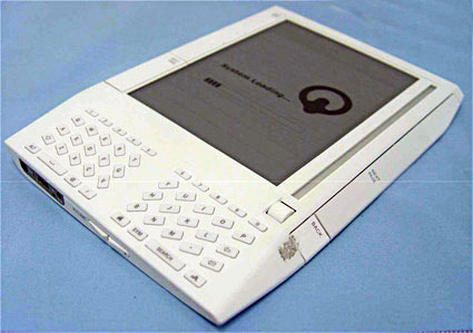Wow!
The Kindle is for sale at Amazon right now, and the details of the device are intriguing. More highlights:
-
It connects to the net via cellular networks, specifically EVDO. So anywhere you can get a cell signal, you can buy a book. And there is no charge for the connectivity…Amazon is underwriting it.
- There looks to be subscription models for newspapers, magazines, etc, all delivered automatically in the background. Wake up every morning and the Times is waiting.
- New York Times® Best Sellers and all New Releases $9.99, unless marked otherwise.
And, my favorites:
- Includes free wireless access to the planet’s most exhaustive and up-to-date encyclopedia—Wikipedia.org.
- By using the keyboard, you can add annotations to text, just like you might write in the margins of a book. And because it is digital, you can edit, delete, and export your notes, highlight and clip key passages, and bookmark pages for future use.
- The source code for the device appears to be available…one can only guess that they leveraged some open source software and are complying with the license. Except that it’s machine readable source…hmmmm.
Here’s the bad:
- They are advertising “more than 250 top blogs…” I take this to mean there is no open RSS reader built in. That seems a nearly criminal omission from the Kindle. I mean, RSS is the backbone of content choice on the web right now…come on Bezos!
- It does support ebooks via Audible…so you can read or listen, as you choose.
- From the License Agreement: “Amazon provides wireless connectivity free of charge to you for certain content shopping and acquisition services on your Device. You will be charged a fee for wireless connectivity for your use of other wireless services on your Device, such as Web browsing and downloading of personal files, should you elect to use those services. We will maintain a list of current fees for such services in the Kindle Store.”
- And here’s a good one: “You agree you will use the wireless connectivity provided by Amazon only in connection with Services Amazon provides for the Device. You may not use the wireless connectivity for any other purpose.”
Ah, and here’s where eBooks and physical books diverge, and is the source of 99% of my frustration with the format (also from the License Agreement):
Use of Digital Content. Upon your payment of the applicable fees set by Amazon, Amazon grants you the non-exclusive right to keep a permanent copy of the applicable Digital Content and to view, use, and display such Digital Content an unlimited number of times, solely on the Device or as authorized by Amazon as part of the Service and solely for your personal, non-commercial use. Digital Content will be deemed licensed to you by Amazon under this Agreement unless otherwise expressly provided by Amazon.
Restrictions. You may not sell, rent, lease, distribute, broadcast, sublicense or otherwise assign any rights to the Digital Content or any portion of it to any third party, and you may not remove any proprietary notices or labels on the Digital Content. In addition, you may not, and you will not encourage, assist or authorize any other person to, bypass, modify, defeat or circumvent security features that protect the Digital Content.
That book you bought? Not yours. Can’t sell it. Can’t even give it away.
Oh, and for those librarians who still hold tight to the privacy bandwagon:
Information Received. The Device Software will provide Amazon with data about your Device and its interaction with the Service (such as available memory, up-time, log files and signal strength) and information related to the content on your Device and your use of it (such as automatic bookmarking of the last page read and content deletions from the Device). Annotations, bookmarks, notes, highlights, or similar markings you make in your Device are backed up through the Service. Information we receive is subject to the Amazon.com Privacy Notice.
They know when you are reading. They know what you are reading, and that you bookmarked the sex scenes. Oh yes, they know.
So, exciting new product? Yep. Amazon, like Apple before them, has realized the power of a closed market segment, where they control the distribution and the consumption of media. The real test will be whether this survives the 2-3 year adoption cycle and moves into the magic price point range ($100-150).




